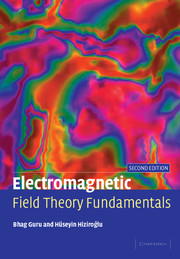Book contents
- Frontmatter
- Contents
- Preface
- Acknowledgments
- 1 Electromagnetic field theory
- 2 Vector analysis
- 3 Electrostatics
- 4 Steady electric currents
- 5 Magnetostatics
- 6 Applications of static fields
- 7 Time-varying electromagnetic fields
- 8 Plane wave propagation
- 9 Transmission lines
- 10 Waveguides and cavity resonators
- 11 Antennas
- 12 Computer-aided analysis of electromagnetic fields
- Appendix A Smith chart and its applications
- Appendix B Computer programs for various problems
- Appendix C Useful mathematical tables
- Index
1 - Electromagnetic field theory
Published online by Cambridge University Press: 05 June 2012
- Frontmatter
- Contents
- Preface
- Acknowledgments
- 1 Electromagnetic field theory
- 2 Vector analysis
- 3 Electrostatics
- 4 Steady electric currents
- 5 Magnetostatics
- 6 Applications of static fields
- 7 Time-varying electromagnetic fields
- 8 Plane wave propagation
- 9 Transmission lines
- 10 Waveguides and cavity resonators
- 11 Antennas
- 12 Computer-aided analysis of electromagnetic fields
- Appendix A Smith chart and its applications
- Appendix B Computer programs for various problems
- Appendix C Useful mathematical tables
- Index
Summary
Introduction
What is a field? Is it a scalar field or a vector field? What is the nature of a field? Is it a continuous or a rotational field? How is the magnetic field produced by a current-carrying coil? How does a capacitor store energy? How does a piece of wire (antenna) radiate or receive signals? How do electromagnetic fields propagate in space? What really happens when electromagnetic energy travels from one end of a hollow pipe (waveguide) to the other? The primary purpose of this text is to answer some of these questions pertaining to electromagnetic fields.
In this chapter we intend to show that the study of electromagnetic field theory is vital to understanding many phenomena that take place in electrical engineering. To do so we make use of some of the concepts and equations of other areas of electrical engineering. We aim to shed light on the origin of these concepts and equations using electromagnetic field theory.
Before we proceed any further, however, we mention that the development of science depends upon some quantities that cannot be defined precisely. We refer to these as fundamental quantities; they are mass(m), length(ℓ), time(t), charge(q), and temperature (T). For example, what is time? When did time begin? Likewise, what is temperature? What is hot or cold? We do have some intuitive feelings about these quantities but lack precise definitions. To measure and express each of these quantities, we need to define a system of units.
- Type
- Chapter
- Information
- Electromagnetic Field Theory Fundamentals , pp. 1 - 13Publisher: Cambridge University PressPrint publication year: 2004
- 6
- Cited by



